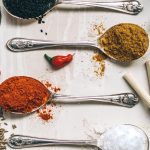The Fall Equinox came and went, and now cooler temperatures and less sunlight are the reality. As we move into Autumn, these seven fruits and veggies will give your health a boost and keep colds at bay!
Rutabaga
Rutabaga is a type of root vegetable and a cross between a turnip and a cabbage. Some classify it as part of the ‘ugly root vegetables’ but you’d be surprised at its nutrient and antioxidant power.
Why is it good?
This purplish root vegetable is rich vitamin C, potassium and beta-carotenoids. It is also rich in fibre and prebiotics which can boost your digestion and immune system.
How to eat it?
Try roasting chunks of rutabaga with a drizzle of olive oil, or boil and mash them with a little milk or milk substitute, just like potatoes. Try keeping their skin for it is where most of its nutrients concentrate.
Figs
This fruit is part of the mulberry family and there are many varieties. Their texture and size make them an optimal snack.
Why is it good?
Figs are a healthy alternative to dairy products. Eight dry figs can provide you with your 10% daily required intake of calcium. They are also high in fibre. 3-5 figs can give you 5 grams (women require 25g/day and men 30-38g/day).
How to eat it?
Eat them when they are ripe for more sweetness. It is best to keep them at room temperature and consume them within the first two days of purchase. Keep them at hand for a healthy snack alternative, especially during those afternoons when you are craving for something sweet. Figs can also be used as a sweetener and a fat substitute in baked goods and are great for homemade dry fruit and nut bars.
Apples & Pears
This season is great to bite into freshly picked apples and pears. These fruits are the perfect low calorie snack. They are easy to carry and are packed with nutrients.
Why is it good?
They are the perfect low calorie snack, easy to carry and packed with nutrients. Eating the skin is key to obtain most of the nutritional benefits of these fruits. The skin is where they concentrate most of the fibre, antioxidant, anti-inflammatory chemicals, and potentially anti-cancer nutrients. They have also been associated with a reduced the risk of type 2 diabetes.
How to eat it?
Eat it fresh and with the skin! Avoid juices. With their pulp removed, pear juices were determined to lose up to 40% of their total phenolic phytonutrients, and to have significantly reduced antioxidant capacity.
Cabbage
Cabbage is a type of cruciferous vegetable. There are many varieties and the darker the colour the more nutrients it is likely to contain.
Why is it good?
One cup of cabbage can provide you with 79% of vitamin K, 69% vitamin C and 20% of vitamin B6 required for a day. It is rich in different types of antioxidants. Red cabbage has an added nutritional benefits due to its red pigment, a sign of antioxidant content. Eating cabbage will provide you with anti-inflammatory benefits, and chemical components that have been associated to cancer and type 2 diabetes prevention.
How to eat it?
You can eat it raw or cooked. Use it as a wrap or tortilla and fill it with your favourite stew. You can also try adding it to a soup or salad to break the routine.
Damson
Damson are similar to plums and a member of the rose family. They are small fruits with a vibrant dark blue skin and a strong, sour flavour and are at their best in September.
Why is it good?
Due to their high fibre and antioxidant content, damsons are great for improving your digestion and lowering your ‘bad’ cholesterol. They have also been associated to the prevention of certain cancers and heart disease.
How to eat it?
Store them the same way as plums. Refrigerate and use within a couple of days. Damson are more suitable for cooking than eating raw and are especially good for jams and jellies. They are also often used in desserts such as pies and tarts. To reduce your sugar intake, they can also be used in savoury dishes such as, roast beef, pork or lamb casseroles.
Fennel bulb
Fennel is a flowering plant species in the carrot family. It is a perennial herb with yellow flowers and leaves that are great for a nutritious garnish. It can be eaten raw, for more crispiness and a strong aniseed flavour, or cooked, to obtain a softer texture and flavour.
Why is it good?
Fennel is an excellent source of vitamin C, fibre, potassium, molybdenum, manganese, copper, phosphorus and folate among many other minerals. Such as calcium and iron.
How to eat it?
Cut a fresh fennel bulb into medium size pieces and toss with olive oil and vinegar and roast until tender. Top with grated fresh parmesan and enjoy as a snack or a side dish. You can also eat it fresh. Prepare a fresh raw fennel salad but adding cucumber, leaves, walnuts, dates and a drizzle of olive oil and lemon.
Globe artichoke
From the leaves to the heart, artichoke can be a great addition to our diet due to its high nutrient content.
Why is it good?
Due to their phytonutrient content, artichokes have more antioxidant power than blueberries or broccoli. They are also abundant in fibre making them optimal for improving your digestion and cholesterol levels.
How to eat it?
Enjoy it as a dip, in a soup or a gratin. You can also grill or roast them and use them as a side, as part of your salad or a main veggie dish.
Eating seasonally will help you obtain the nutrients that your body needs for this period and will also help you take care of the environment by reducing your carbon foot print. By increasing your vegetable consumption you will see how your skin tone improves, your energy increases and your immune system becomes stronger. Check how to change your dietary habits and increase your veggie consumption in our next article.













